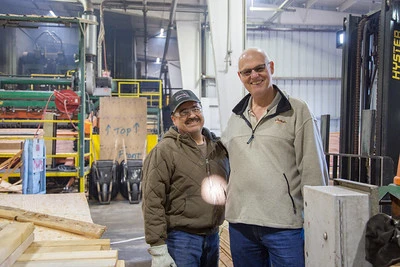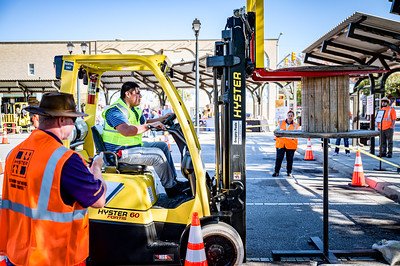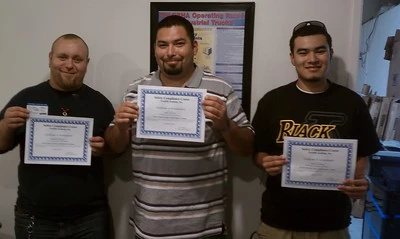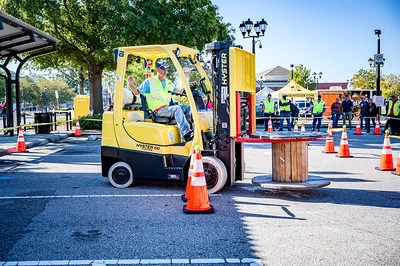Do You Have To Be Certified To Train Forklift Operator?
April 5, 2024 | by onlineoshasafetytraining.com


To put it in simple terms, if you want to teach someone how to operate a forklift, there’s a specific rule from OSHA you need to follow. According to OSHA rule 29 CFR 1910.178(l)(2)(iii), the person who trains forklift operators must have the proper knowledge, training, and experience to teach others and evaluate their competence. This doesn’t mean they need a special certificate to be a trainer, but they do need to know what they’re doing, both in operating the forklift and in teaching others how to do so safely.
Here’s a more detailed explanation of what the regulation entails:
- Knowledge and Experience: The trainer must have a solid understanding of what they are teaching. This means they need to be well-versed in operating a forklift, including all safety procedures, operational nuances, and potential hazards. This knowledge typically comes from direct experience with forklift operation in various conditions and settings.
- Training Skills: Beyond knowing how to operate a forklift safely, the trainer must also be capable of transferring this knowledge effectively to new operators. This involves understanding how to communicate clearly, how to demonstrate techniques properly, and how to assess the trainees’ ability to understand and apply what they’ve learned.
- Evaluation Competence: The trainer is not just responsible for teaching but also for evaluating the competence of the operators they train. This means they must be able to judge whether a trainee can operate a forklift safely and efficiently in the workplace. This evaluation is crucial as it determines if the trainee can be certified as a competent operator.
- No Specific Certification for Trainers: Interestingly, OSHA does not require trainers to hold a specific certification to train others in forklift operation. However, the regulation implicitly requires trainers to have a certain level of credibility, derived from their experience, knowledge, and training abilities. This ensures that the training is both effective and adheres to safety standards.
- Continuous Learning: Given the evolving nature of workplace safety standards, trainers are also expected to stay informed about the latest safety protocols and operational advancements in forklift technology. This continuous learning helps in updating the training content and methods to reflect current best practices.
While OSHA doesn’t mandate a specific certificate for forklift trainers, it sets high standards for who can train others. This approach ensures that the training quality is high, reducing the risk of accidents and injuries, and promoting a culture of safety in workplaces that use forklifts.
If You’re an Employer, You Can Assign an Experience Operator To Act as a Trainer
as an employer, you can indeed assign an experienced operator to act as a trainer for new or less experienced forklift operators. This is in line with OSHA’s regulation on forklift operator training. The key requirement is that the chosen individual must possess the necessary knowledge, training, and experience to conduct training effectively and evaluate the competence of the trainees.
Here’s how this works:
- Experience and Knowledge: The experienced operator chosen to be a trainer should have extensive operational experience with forklifts. This experience should not only cover the basic operation of the forklift but also safety practices, troubleshooting, and understanding of different operating environments. They should be familiar with the specific types of forklifts used in your operation and their safety features.
- Demonstrated Ability to Train: Just being experienced in operating a forklift doesn’t automatically qualify someone to train others. The chosen trainer should also have the ability or potential to effectively communicate knowledge and skills to trainees. This might include the ability to demonstrate tasks, explain concepts clearly, and use training aids or materials effectively.
- Evaluation Skills: The experienced operator turned trainer must be capable of assessing a trainee’s competence in operating a forklift. This involves not just a one-time test but ongoing observation and evaluation to ensure that the trainee consistently follows safety procedures and operates the forklift efficiently.
- Understand Legal and Company Policies: The trainer should be well-versed in both OSHA regulations and any specific company policies related to forklift operation. This ensures that the training not only complies with legal standards but also aligns with your company’s specific operational procedures and safety guidelines.
- Training in How to Train: While not explicitly required by OSHA, it’s beneficial if the experienced operator receives some training on how to train others. This could include instruction on adult learning principles, instructional techniques, and how to give effective feedback. Such training can greatly enhance the quality and effectiveness of the training provided.
By assigning an experienced operator as a trainer, you’re leveraging their hands-on experience and insight, which can be incredibly valuable to trainees. However, it’s crucial to ensure that the chosen individual not only knows how to operate a forklift safely but also how to teach those skills to others effectively.
If This Operator Is Lacking Some Qualifications, You Can have Him Take Forklift Train The Trainer Course
If the operator you want to teach others how to use a forklift doesn’t have all the skills they need yet, you can sign them up for a special class called “Forklift Train-the-Trainer.” This class teaches them how to be good teachers, making sure they know how to explain things clearly, keep everyone’s attention, and make sure everyone understands the safety rules.
They’ll learn how to plan their lessons, test how well people are learning, and feel more confident standing up in front of a group. Plus, they get a certificate at the end that says they’re qualified to teach others, which is good for following the rules and making sure they’re really ready to help others learn how to safely operate a forklift.
Here’s How to Appoint Someone From The Team
Appointing an employee to train other forklift operators involves a thoughtful process to ensure that the trainer is qualified and capable of effectively passing on necessary skills and safety knowledge. Here’s a simplified guide to help you through this process:
- Pick the Right Person:
- Look for someone who not only excels in forklift operation but also possesses strong communication skills. They should have a thorough understanding of all safety protocols and a clean safety record. Observing how they interact with coworkers and handle stressful situations can give you insight into their potential as a trainer.
- Check Their Skills:
- Conduct a formal assessment of their forklift operation skills, including both written tests and practical demonstrations. This should cover a wide range of knowledge, from the basics of operating different forklift types to more complex scenarios like handling hazardous materials or navigating tight spaces. It’s also crucial to ensure they’re up to date with the latest OSHA safety regulations.
- Teach Them to Teach:
- Enroll them in a comprehensive “Train-the-Trainer” program that focuses on teaching methodologies, adult learning principles, and effective communication strategies. The course should also cover how to create engaging training materials and how to adapt teaching methods to accommodate different learning styles. Look for programs that include practice teaching sessions with real feedback.
- Give Them Tools:
- Compile a training kit that includes all necessary materials, such as safety manuals, operation checklists, and troubleshooting guides. Also, provide access to a variety of forklifts for practical demonstrations, ensuring they can show trainees the nuances of each model. Incorporating multimedia resources like videos or interactive software can also enhance the learning experience.
- Start Teaching:
- Begin with smaller, controlled training sessions, possibly with a friendly audience of coworkers who can provide constructive feedback. It’s beneficial to have an experienced trainer observe these initial sessions to offer tips and corrections. Gradually increase the complexity of the training and the size of the audience as the new trainer gains confidence and proficiency.
- Keep Them Learning:
- Set up a continuous professional development plan for your trainer. This could include subscriptions to industry publications, attendance at workshops or seminars related to forklift operation and safety, and opportunities to attain advanced certifications. Encourage them to stay connected with a network of professional trainers for mutual support and knowledge exchange.
By taking these detailed steps, you not only prepare your chosen employee for the role of a forklift trainer but also ensure a high standard of training for your team, leading to a safer and more efficient workplace.
You Can Take the Train-The-Trainer Course Online
You can also choose to do the Train-the-Trainer course online. This means you can learn how to teach others about forklift safety and operation from your computer at home or work. These online courses cover all the important stuff, like how to explain things clearly, make sure everyone understands the safety rules, and even how to keep training interesting. Plus, learning online gives you the flexibility to study at your own pace and fit the training into your schedule.
With the online Train-the-Trainer course, you’ll get into the details of what makes a great training session. You’ll learn about different ways people pick up new skills, so you can make sure your training clicks with everyone, whether they learn best by listening, watching, or doing. The course will also show you how to set up practice exercises that are just like the real deal, helping folks get hands-on experience in a safe way.
Since it’s all online, you can revisit any part of the course whenever you need a refresher. Plus, there are usually forums or support groups where you can ask questions or get advice from others who are learning to be trainers too. And when you finish the course, you’ll often get a certificate that you can show your boss, proving you’ve got the know-how to teach others about forklift safety and operation. This way, not only do you boost your skills, but you also add value to your workplace by ensuring everyone’s up to speed on safe forklift use.
Having an In-House Trainer Can Save The Company A Lot of Resources
Think of it this way: When someone in your place knows how to teach everyone else the right way to use forklifts, it’s like finding a shortcut to save money and trouble. You don’t have to pay outsiders to come in and teach, which can be pretty pricey. Your own trainer knows the ins and outs of your work area better than anyone else, so they can make the training spot-on for what your team actually does every day. This means your folks learn better and use the forklifts the right way.
When everyone’s up to speed on how to stay safe with forklifts, there’s less chance someone will have an accident. Fewer accidents mean you’re not losing time or money because someone got hurt or a forklift got banged up. Plus, when forklifts are used the right way, they last longer and work better, so you’re not constantly fixing or replacing them.
Also, being on top of this training stuff helps spot small problems before they turn into big headaches, keeping costs down even more. And don’t forget, when your team feels taken care of and knows how to do their jobs well, they’re happier at work. Happy workers stick around longer, which means you’re not always spending time and money to hire new people.
So, getting one of your own to be that go-to trainer is a smart move. It’s all about doing things smarter, not harder, keeping everyone safe, and saving a bunch of cash and hassle along the way.
To Make a Conclusion
You don’t need a special certificate just to teach others how to use a forklift safely. What you really need is to know your stuff when it comes to forklifts, understand all the safety rules, and be good at sharing that knowledge with others. However, taking a Train-the-Trainer course, which you can even do online, is a smart move. It’ll give you a solid background in how to teach effectively and make sure you’re up to date on all the latest safety standards. This kind of preparation not only makes you a better trainer but also keeps everyone at work safe.
RELATED POSTS
View all


